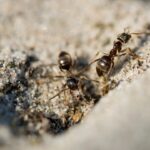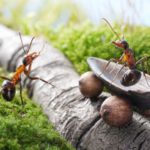In this article, we will discuss red velvet ants and cow killer ants. How do they sting, is their sting poisonous, what’s the pain level, and what to do in case of red velvet and cow killer ant sting? You can find out more details about ants.
What is a red velvet ant?
A common name for a family of wasps in the Mutillidae family is “red velvet ant”. Red velvet ants are female wasps without wings, despite their name suggesting otherwise. These insects have powerful stings and eye-catching looks. The red velvet ant’s profile is as follows:

What do red velvet ants look like?
Color
Red velvet ants frequently have vivid colors, primarily red and black. Some reds may appear more orange or brownish, and the intensity of the color might vary.
Body
These ants have a velvety texture due to a thick layer of tiny hairs covering their exoskeleton. Additionally, the hairs may act as a deterrent to predators.
Size
In comparison to other ant species, female red velvet ants can reach lengths of 0.2 to 1 inch (5 to 25 mm).
Shape
Males have wings, and females have none. The males resemble wasps more in appearance and are usually smaller.
Habitat
Red velvet ants live in a variety of habitats, including grasslands, meadows, and sandy areas. They are most active during the warm months and can they are in both rural and suburban environments.
Red velvet stinging profile
Red velvet ants have a reputation for having strong stings. Contrary to popular belief, red velvet ants are not genuine ants; rather, they are female wasps belonging to the Mutillidae family. With its strong stinger, the females have some of the most excruciating stings among any insects. Severe pain, redness, and swelling at the sting site are possible side effects of the sting. People may occasionally suffer from allergic responses.

Is the sting painful?
As a last resort, wasps will sting to startle a predator into releasing their grip, allowing them to escape without causing significant harm or death. Although the venom of velvet ants is almost twenty-five times less poisonous than that of honeybees.
Red velvet ant stings can be extremely painful, frequently ranking among the most excruciating insect stings that humans have ever endured. As a defense, the female red velvet ants are wingless wasps with strong stingers. On a scale of zero to four, their pain ranking is 3 which is impressive.

How long do the sting symptoms last?
A red velvet ant sting can cause excruciating pain that can linger for a considerable amount of time. Localized redness, burning, and swelling may result from the sting’s venom injection. More severe symptoms could result from an allergic reaction to the venom in certain individuals.

Avoiding red velvet ant sting
It’s crucial to remember that red velvet ants normally don’t bite people; they usually only sting when they feel threatened. Refrain from touching or upsetting them to lessen the red velvet sting. It’s better to watch red velvet ants from a safe distance than to try to handle them if you encounter one.

Cow Killer Ants
Velvet ants are a species of wasp that goes by the common name “cow killer ant.” Similar to the red velvet ants, cow killer ants belong to the Mutillidae family. It’s crucial to remember that these are female wasps without wings, not actual ants.

Do they kill cows?
Cow killer ants don’t kill cows. They get the name from their painful sting as if if can kill a cow! They’re wasps. Given their vivid red color, wasps serve as a deterrent to potential predators. A painful sting awaits predators who disregard this warning. Although these stings cause pain, they are not deadly, and their sting cannot kill a cow.
Red velvet ants and cow killer ants
One species of velvet ant is the cow killer ant (Dasymutilla occidentalis), often known as the eastern or red velvet ant. Velvet ants are wasps, but they get their name from their fuzzy, frequently wingless bodies, which make them look like big, hairy ants.
Apesmatic color
There are various strategies that both sexes employ to stay safe. Apesmatic coloring, in which an animal uses vivid colors to ward off predators, is exemplified by their vivid red hue. Numerous creatures, such as the lion zebrafish and the golden poison frog, display aposematic coloring.
Gender-based appearance
Because cow killer ants are a sexually dimorphic species, their male and female members have distinct traits. When it comes to cow killer ants, the males and females have such dissimilar appearances that many people are unaware they belong to the same species.
Female cow killer ant
Since they lack wings, female cow killer ants are more likely on the ground. Their short, vivid hair, which varies in hue from vivid red to reddish-orange, covers their ebony bodies. They frequently have black hairs on the legs, between the abdomen and thorax, and in a stripe across the thorax.
Male cow killer ant
Male cow killer ants have dark brown or black wings and similar hues with slightly varied patterns. The size of cow killer ants varies with sex as well. Males can grow larger, but females are typically three-quarters of an inch long.
The sting of cow killer ant
Some of the characteristics of cow killer ant sting are given below:
Pain intensity
Their sting has a very high rating. It’s so powerful that it can kill a cow, although it cannot kill a cow. The term is only used to describe the level of pain caused by its sting.
Pain duration
When a cow killer ant stings you, the pain can endure for a very long time. In certain situations, it can last for an hour or longer.
Venom
Velvet ants, which include cow killers, have venom that comprises compounds that can burn painfully and cause extreme suffering. In addition to being acute, the pain may also last for a long time.
Allergic Reaction
While localized pain and swelling are common in most cases, some people may be allergic to the venom, which could result in more severe reactions. Breathing difficulties, hives, and, in severe situations, anaphylaxis are examples of allergic reactions.
Caution
Cow killer ants can be very unpleasant to sting, therefore it’s best to be careful around them and not handle or disturb them. Although they don’t usually attack people, they might sting if they feel threatened.
What to do in case of cow killer ant sting
If you are stung by a cow killer ant or red velvet ant, it’s recommended to:
- Use soap and water to clean the impacted area.
- Use a cold compress to minimize swelling.
- If necessary, take over-the-counter painkillers.
- Keep an eye out for any indications of an allergic response, and if you experience severe symptoms, get help right once.
Since each person reacts differently to stings, evaluating the situation and taking the necessary action depends on how severe the reaction is is important. It’s critical to seek immediate medical assistance if there are any questions or if there are symptoms of allergic reactions.

Frequently Asked Questions (FAQs) about cow killer/ red velvet ant stings
Q1. What happens if you get stung by a red velvet ant?
Acetylcholine, histamine, and serotonin are some of the chemicals that make velvet ant stings painful. Velvet ant stings are extremely painful and result in localized edema and redness. Though theoretically plausible, there are no examples of anaphylaxis following a velvet ant sting in the literature.
Q2. Is red velvet ant poisonous?
Males with wings are harmless, while females without wings can sting quite painfully. Despite being excruciatingly unpleasant, the sting is rarely harmful. The moniker “cow killers” is unjustified. Their vivid coloring serves as a warning of potential danger, much like a yellow or red traffic light.
Q3. What is the pain level of a red velvet ant sting?
The pain level of red velvet ant sting is 3. The sting pain can last anywhere from 30 minutes (like the sting of a velvet ant) to one minute (like the sting of a red paper wasp).
Q4. How do you treat red velvet ant stings?
Any debris or bacteria that can exacerbate the sting can be eliminated by washing the afflicted area with soap and water. Reducing swelling and pain at the sting site can be achieved by applying an ice pack or cold compress. Acetaminophen and ibuprofen, two over-the-counter pain medications, can help with pain relief and edema reduction.
Q5. How poisonous are cow killer ants?
They are known as “cow killers” because, if handled or stomped on, they may cause an agonizing sting. No cow has ever, as far as we know, passed away from a sting. Even though the venom is not extremely lethal, the sting may be excruciating.
Q6. Which ant is called a cow killer?
Red velvet ants not only sting, but their female counterparts’ stings are exceedingly strong as well, earning them the moniker “cow killer ant” due to the urban legend that the sting is so excruciatingly painful that it could kill a cow. Although the venom is not extremely toxic, the sting is quite painful.
Stay tuned to insectinsider to get more exciting information about the insect world!






